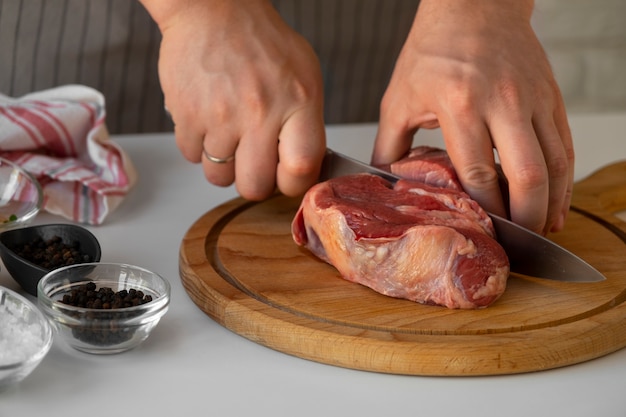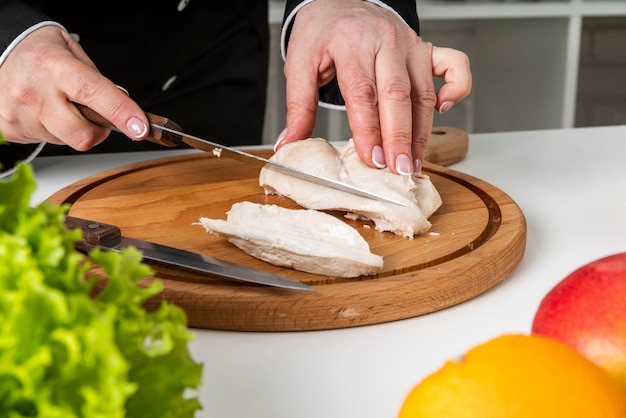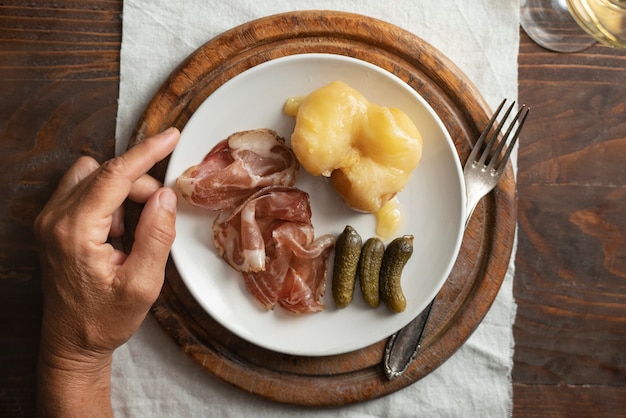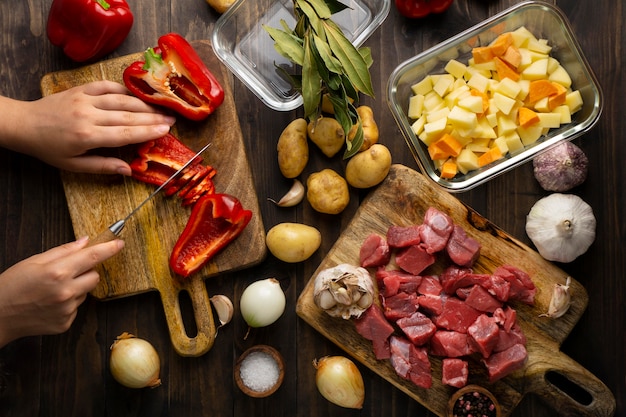pre-cooked hams are a real godsend, aren't they? They're so convenient, you can whip up a delicious meal in a flash, perfect for a busy weeknight or a special occasion. But sometimes, you find yourself staring at the instructions on the package, feeling a bit lost. "How long do I actually cook this thing?" I've been there too. Don't worry, I'm here to help! I'm going to break down the process for you, sharing my personal tips and tricks based on years of experience, so you can create the perfect, juicy ham every time.
(Part 1) The Wonderful World of Pre-Cooked Hams

Before we dive into the cooking details, let's talk about the different types of pre-cooked hams you might find in the grocery store. Understanding these different types will help you choose the right ham for your meal and give you a better grasp of how to cook it.
The Pre-Cooked Ham Lineup
Here's a quick rundown of the most common types of pre-cooked hams you'll encounter:
- spiral-sliced ham: These are the most popular pre-cooked hams. They're fully cooked and come in a spiral cut, which makes them super easy to slice and serve. You often find them glazed, adding a layer of sweetness and flavour. This is my go-to for a quick and easy meal.
- bone-in ham: These are often a centrepiece for holiday dinners. They can be fully cooked or partially cooked. If it's partially cooked, it'll need a bit more time in the oven to reach a safe temperature. Bone-in hams are fantastic for roasting, and the bone adds a wonderful flavour to the meat.
- Ham steaks: These are pre-cooked slices of ham, ideal for grilling, pan-frying, or even using in a sandwich. They're a great option for a quick meal or a simple weeknight dinner.
So, keep an eye out for these types of pre-cooked hams at the supermarket. It's good to know what you're looking at when you're making your selection.
(Part 2) Deciphering the Package Instructions

Now, you've got your pre-cooked ham, and it's time to face the instructions. Don't panic! They are there to help. However, they can be a bit confusing at times. Let me guide you through it.
Decoding the Language of Ham Packaging
Here's what you need to look for on the packaging, to make sure you're cooking your ham safely and properly:
- "Fully Cooked" or "Ready to Eat": This means the ham is safe to eat right out of the package, but you can reheat it for a more enjoyable experience. No extra cooking is required, though.
- "Partially Cooked": This indicates the ham needs additional cooking. Pay close attention to the specific instructions on the package. You'll want to make sure the ham reaches a safe internal temperature.
- "Microwave Safe": This tells you that you can safely reheat the ham in your microwave, but remember, microwaving can sometimes dry out ham, so it's best for smaller portions or when you're in a hurry.
- "Oven Safe": This means the ham can be reheated in the oven, which is my preferred method for getting a nice, even heat.
If the package mentions a specific cooking time, I always aim for that as a starting point. But, if you're not sure or the instructions are vague, you can usually find more detailed information online, or, you know, just ask me!
(Part 3) The Oven: Your Ham's Best Friend

Here's the most common way to reheat a pre-cooked ham. It's a classic method, it's easy, and it yields delicious results. I've used this method for years, and it's always been a crowd-pleaser.
Step-by-Step Guide to Oven Reheating
Here's what you need to do:
- Preheat: Preheat your oven to 325°F (160°C). This will give you an even heat for cooking your ham.
- Prepare: Place the ham in a roasting pan, fat-side up. You can add a little water to the bottom of the pan to help keep it moist. I've found that this helps to create a nice, juicy ham.
- Cook: Cook for about 15 minutes per pound, or until the internal temperature reaches 140°F (60°C). Use a meat thermometer to check the internal temperature, as this will ensure the ham is cooked safely.
- Rest: Let the ham rest for 10-15 minutes before slicing. This will allow the juices to redistribute, resulting in a juicier ham.
Now, you're probably thinking, "What if my ham is already glazed?" Good question! In that case, you can skip the glaze, as it will likely be caramelized and delicious from the original cooking. But, if you want to add a bit more flavour, feel free to brush it with a honey-mustard glaze or a brown sugar glaze during the last 30 minutes of cooking. This will give it a beautiful, glossy finish and add a burst of sweetness.
(Part 4) Microwaving: A Quick and Easy Option
Sometimes, you just need a quick and easy meal. And that's where the microwave comes in handy. You can reheat your pre-cooked ham in the microwave in no time.
Microwaving Tips for a Juicy Ham
Here are some things to keep in mind when microwaving your ham:
- Cover: Cover the ham loosely with plastic wrap to help retain moisture. This will prevent the ham from drying out too much during the reheating process.
- Time: Microwave on high power for about 5 minutes per pound. This is just a guideline, so you might need to adjust the time based on your microwave's power.
- Check: Check the internal temperature with a meat thermometer to make sure it reaches 140°F (60°C). This is essential for food safety.
- Rest: Let the ham rest for a few minutes before slicing to allow the juices to redistribute. This will make your ham more juicy and flavorful.
Just remember, microwaving can sometimes dry out ham. It's best to use the microwave for smaller portions or if you're in a real hurry.
(Part 5) Stovetop Reheating: A Gentle Approach
Sometimes, I just feel like a good old-fashioned stovetop method. It's a bit slower, but it's a great option if you want a more controlled and even heating.
Stovetop Reheating for a Gentle Approach
Here's how to do it:
- Skillet: Place the ham in a large skillet or dutch oven. You'll want a pan that's big enough to accommodate the ham comfortably.
- Liquid: Add about 1/2 cup of water or broth to the bottom of the pan to help keep the ham moist. This will prevent the ham from drying out and create a flavorful sauce.
- Heat: Cover the skillet and simmer over low heat for about 20 minutes, or until the ham is heated through. This gentle simmering will ensure the ham cooks evenly without drying out.
- Check: Use a meat thermometer to check the internal temperature, ensuring it reaches 140°F (60°C).
- Rest: Let the ham rest for a few minutes before slicing. This will allow the juices to redistribute, resulting in a juicier ham.
I love this method because it allows the flavours to meld together, especially if you're using a flavorful broth or adding spices.
(Part 6) slow cooker Magic: The Stress-Free Method
Here's another favorite of mine: the slow cooker. It's a great way to reheat a pre-cooked ham and keep it warm for hours. Perfect for a party or a casual gathering.
Slow Cooker Magic for a Stress-Free Meal
Follow these simple steps:
- Place: Place the ham in the slow cooker. Make sure it fits comfortably in your slow cooker.
- Liquid: Add about 1/2 cup of water or broth to the bottom of the slow cooker to prevent it from drying out. This will also create a flavorful sauce that you can use to serve with the ham.
- Cook: Cook on low heat for 3-4 hours, or on high heat for 1-2 hours. This will give you a nice, slow and gentle cooking process, ensuring a juicy and flavorful ham.
- Check: Check the internal temperature with a meat thermometer to ensure it reaches 140°F (60°C).
Now, the slow cooker is really good at retaining moisture, so your ham will be nice and juicy. It's also a great way to make a delicious pulled ham. Just shred the ham after it's cooked and you've got a fantastic base for sandwiches, tacos, or other dishes.
(Part 7) Serving Up Your Reheated Ham
You've done it! Your pre-cooked ham is reheated and ready to be devoured. Time to put on your chef hat and get ready to serve up a delicious meal.
Ideas for Serving a Pre-Cooked Ham
Here are some ideas for serving your ham:
- Classic: Serve it sliced on a platter with crusty bread, mashed potatoes, and green beans. This is a classic combination that never fails to please.
- Sandwich: Make ham sandwiches with pickles, mustard, and swiss cheese. A simple but satisfying meal.
- Salad: Toss ham cubes with your favourite salad greens, fruits, and a vinaigrette. A light and refreshing meal, perfect for warm weather.
- Pasta: Add diced ham to a pasta dish for a hearty and flavorful meal. You can use it in a carbonara, a creamy pasta sauce, or even a simple tomato sauce.
- Soup: Use ham bones to make a flavorful soup stock. This is a great way to use up the bones and add a delicious, rich flavor to your soup.
The possibilities are endless! Get creative and have fun with it.
(Part 8) Storing Your Reheated Ham
You've reheated your ham, and you're ready to enjoy it. But, what about any leftovers? I know, the feeling of having a delicious ham in the fridge is exciting! But, it's important to store it properly to keep it safe and delicious.
Storing Leftovers for Maximum Freshness
Here's what to do:
- Cool: Let the ham cool to room temperature before storing it in the refrigerator. This will prevent the temperature in your refrigerator from rising too high.
- Wrap: Wrap it tightly in plastic wrap or aluminum foil. This will help to prevent the ham from drying out and keep it fresh.
- Refrigerate: Store it in the refrigerator for up to 3-4 days. It's best to use leftovers within a few days for the best quality.
If you're not planning on using the leftovers within a few days, you can freeze them for up to 2 months. To freeze, wrap the ham tightly in plastic wrap and aluminum foil. This will help to prevent freezer burn.
(Part 9) Tips for Perfect ham reheating
Now, I've been through this a few times, and I've learned a few tricks along the way. These tips will help you get that perfect, juicy ham every time.
Insider Tricks for Delicious Ham
- Don't Overcook: Pre-cooked hams are already cooked, so don't overcook them. You'll just end up with a dry and tough ham.
- Temperature is Key: Use a meat thermometer to ensure the ham reaches 140°F (60°C). This is the safe internal temperature for cooked pork.
- Rest Time: Let the ham rest for 10-15 minutes after cooking to allow the juices to redistribute. This will make your ham juicier and more flavorful.
- Moisturize: Add a little water or broth to the bottom of the pan to help keep the ham moist. This will prevent the ham from drying out during cooking.
- Glaze It Up: Consider brushing the ham with a glaze during the last 30 minutes of cooking for extra flavor. A glaze will give the ham a beautiful, glossy finish and add a layer of sweetness.
Follow these tips, and you'll be rewarded with a delicious, juicy ham every time.
(Part 10) FAQs: Your Ham Reheating Questions Answered
Okay, let's get to some frequently asked questions that you might have about reheating your pre-cooked ham.
1. Can I Reheat a Pre-Cooked Ham Twice?
Technically, yes, you can reheat a pre-cooked ham twice. However, each reheating session will dry it out a little more, so it's best to avoid reheating it more than once if possible. If you do need to reheat it twice, make sure you add plenty of moisture to the pan and cook it gently.
2. How Do I Know When a Pre-Cooked Ham is Done?
The best way to determine if a pre-cooked ham is done is by using a meat thermometer. Insert the thermometer into the thickest part of the ham, making sure it's not touching any bone. The internal temperature should reach 140°F (60°C) for safety. This will ensure that the ham is cooked through and safe to eat.
3. Can I Reheat a Pre-Cooked Ham in the Air Fryer?
Yes, you can reheat a pre-cooked ham in an air fryer. It's a great way to get a crispy exterior. Simply place the ham in the air fryer basket and cook at 350°F (175°C) for about 5-10 minutes, or until heated through.
4. What Happens if I Overcook a Pre-Cooked Ham?
If you overcook a pre-cooked ham, it will become dry and tough. It won't be unsafe to eat, but it won't be as delicious. It's best to avoid overcooking your ham and to use a meat thermometer to ensure it reaches the correct internal temperature.
5. What Can I Do with Leftover Pre-Cooked Ham?
There are endless possibilities for leftover pre-cooked ham! You can dice it up and add it to salads, soups, or pasta dishes. You can also make ham and cheese sandwiches or use it to create a flavorful breakfast hash. Get creative and have fun with it!
Well, that's it! You are now a master of pre-cooked ham reheating! You've got all the knowledge and tips to make a delicious meal that everyone will enjoy. So, go forth, cook your ham, and impress your friends and family with your culinary skills. Happy cooking!
Everyone is watching

Perfect Rice Every Time: The Ultimate Guide to Cooking Rice
Cooking TipsAs a self-proclaimed foodie, I've always been a bit obsessed with rice. It's the foundation of countless cuisi...

Ultimate Guide to Cooking the Perfect Thanksgiving Turkey
Cooking TipsThanksgiving. Just the word conjures up images of overflowing tables laden with delicious food, the scent of r...

The Ultimate Guide to Cooking Asparagus: Tips, Techniques, and Recipes
Cooking TipsAsparagus. The mere mention of this spring delicacy conjures up images of vibrant green spears, crisp and burs...

Can You Cook Spaghetti with Gasoline? (The Shocking Truth)
Cooking TipsWe've all seen those crazy internet trends. You know, the ones that make you wonder, "Did someone actually try...

Chorizo and Eggs Recipe: The Ultimate Guide
Cooking TipsRight, let’s talk about chorizo and eggs. You know, that classic Spanish dish that's always a winner. It's th...
